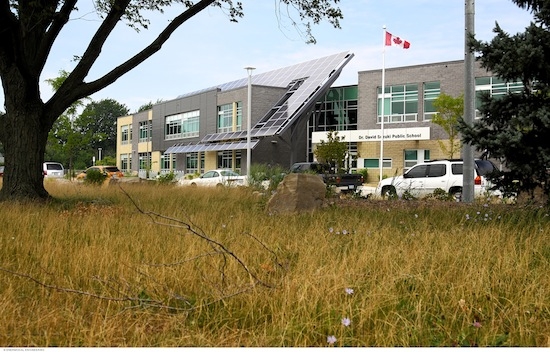
News
Dr. David Suzuki Public School achieves LEED Platinum certification
November 15, 2011 - The Dr. David Suzuki Public School is calling itself the most energy-efficient school in Canada, after becoming the country’s first LEED (Leadership in Energy and Environmental Design) Platinum certified school and achieving all 10 Optimized Energy points.
November 15, 2011 By Alyssa Dalton

According to the school, the first two months of post-occupancy building commissioning helped bring energy use below the predicted energy use to achieve a metered 86 ekWh/m2 compared with the Canadian school average of 281 ekWh/m2.
“Very few LEED projects achieve all 10 Optimized Energy Performance points available under the LEED Canada rating system,” said the Ontario school. “[Our] design team made this goal a reality through the construction of an highly insulated, impeccably sealed building envelope and the use of an innovative mechanical design that included a groundsource heat pump.”
To help decrease the energy needed to treat ventilation air, fresh air is brought in through five intake units – one connected to a solar wall, one connected to earth tubes and three fitted with energy recovery ventilators, explained the school. Here, the air sent through the solar wall is heated by the sun as it passes behind the solar panels, while the air passing through the concrete earth tubes is pre-heated or pre-cooled by the ground before entering the building’s ventilation system, it added. To encourage natural ventilation and cooling when possible, an optimal condition indicator light in each classroom indicates when windows should be opened.
“Light wells” were implemented in the hallways to help decrease lighting load by lighting the first and second floors, while a sawtooth window let light into the centre of the building. Occupancy sensors were also installed in classrooms that turn on automatically.
The school also features a living “green” interior wall, a second-floor green roof outdoor classroom, and produces renewable energy through a 36 kW PV system and horizontal and vertical axis wind turbines, it added.
“This is a great example of how a green building can really serve the owner – with low energy bills – and the occupant, in this case students – by creating a truly ‘living classroom’ where they can directly learn about sustainable design,” said Stephen Carpenter, president of Enermodal Engineering, the LEED consultant and commissioning agent on the project. “Although there are limited school board construction budgets and grants, there is significant public interest in achieving healthy, productive learning environments and decreasing school operating costs.”
“Schools can present a challenge because, in addition to budget constraints, sustainable design has not always been a top priority given tight design and construction schedules, diverse stakeholders, and conventional, rigid school building standards,” he continued.
To help the students see the various technologies and design strategies at work, the construction team also implemented different visual elements around the building, such as:
• The walls of the mechanical rooms are glazed;
• A green roof classroom;
• A visible rooftop solar sun tracker;
• Transparent radiant floor panel; and
• A clear pipe in the hallway that shows rainwater being sent from the roof to the concrete cistern below ground.
Print this page